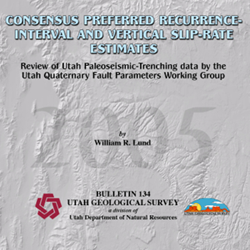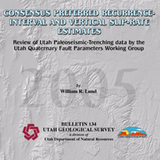Consensus preferred recurrence-interval and vertical slip-rate estimates: review of Utah paleoseismic-trenching data the Utah Quaternary Fault parameters Working Group (B-134)
By: W. R. Lund
This report presents the results of the Utah Quaternary Fault Parameters Working Group (hereafter referred to as the Working Group) review and evaluation of Utah’s Quaternary fault paleoseismic-trenching data. The purpose of the review was to (1) critically evaluate the accuracy and completeness of the paleoseismictrenching data, particularly regarding earthquake timing and displacement, (2) where the data permit, assign consensus, preferred recurrence-interval (RI) and vertical slip-rate (VSR) estimates with appropriate confidence limits to the faults/fault sections under review, and (3) identify critical gaps in the paleoseismic data and recommend where and what kinds of additional paleoseismic studies should be performed to ensure that Utah’s earthquake hazard is adequately documented and understood. It is important to note that, with the exception of the Great Salt Lake fault zone, the Working Group’s review was limited to faults/fault sections having paleoseismic-trenching data. Most Quaternary faults/fault sections in Utah have not been trenched, but many have RI and VSR estimates based on tectonic geomorphology or other non-trench-derived studies. Black and others compiled the RI and VSR data for Utah’s Quaternary faults, both those with and without trenches.
Other Information:<5r />
Published: 2003
Pages: 109 p.
Location: Box Elder, Cache, Davis, Duchesne, Juab, Millard, Morgan, Rich, Salt Lake, Sanpete, Summit, Tooele, Uintah, Utah, Wasatch, Washington, and Weber Counties







